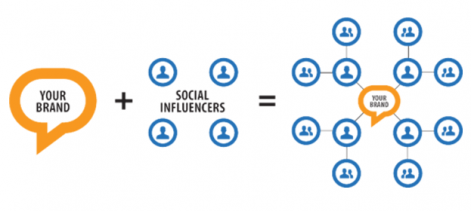There’s a common misconception that you need to hit the biggest influencers to get the biggest results. The more eyes they get, the more eyes you get, right? Well, not necessarily.
We asked our Viral Visionaries about the benefits of working with smaller influencers, and whether you need to spend over the odds promoting your products to the online hivemind.
From my experience (not directly working on a marketing campaign) I’ve seen campaigns be more successful when they’re highly targeted. Depending on the game, it makes more sense to go after the engaged players you know you can speak to, and can relate to the content you’re creating. It’s difficult to find an influencer that can appeal at scale, and if you do find one, having them fit in with your brand and what you want to do can be challenging.
Smaller influencers are generally keen to partner with game developers and publishers because they’re still trying to establish their own brand and grow their fan base. The relationship can be mutually beneficial, as they need you as much as you need them. You can have an ongoing dialogue and work with them instead of paying a lump sum to a large broadcaster for a transactional one-time experience.
Audience relevance comes before scale every time; if you're launching a new brand of snow tyre deodorant, all the spend in the world isn't going convert a Minecraft audience successfully.
Micro-influencers often carve out their audiences based on a particular gaming or genre focus, and while the audience sizes are smaller, it's a highly-engaged audience. This comes across in the watchtime (audience minutes) a VOD or Livestream generates, and why the headline stats of subs/followers can sometimes misrepresent the small to mid-tier channels.

Pascal Clarysse started looking for so-called Growth Hacks a good decade before the buzzword was coined.
Clarysse used to be the marketing driving force at Lik-Sang.com, where he was in charge of relentlessly spotting new trends, waves and magic holes. In recent years, he's served as a marketing consultant for various indie studios, participating in launching mobile games and the occasional Kickstarter campaign.
Naturally, the ambitious marketer will always look for scale and impact, not only on YouTube but in any campaign on any platform. This being said, at the end of the day, we all know that sometimes a small pocket of quality, loyal users with great brand or product affinity is also a win. You can't run a big watercooler event every single day, and in the digital age, marketing is all about rhythm. You have to think about your daily bread and butter too.
The subscribers amount is kind of misleading. A better KPI is the average views per video in recent times, and the velocity at which these views are garnered. That's my personal rule of thumb. Some channels with millions of subscribers were hot a few years back and have now lost their momentum. Like with everything in entertainment, it's hard to last. And users rarely hit that unsubscribe button but it doesn't mean they keep watching the content.

Jiri is the founder of Shark Punch, a transatlantic game development company working on a game about bank robberies in the 70s.
He was the CEO and a founder of the cross-platform gaming pioneer Rocket Pack, which was acquired by Disney in 2011.
He has been part of the Finnish games industry for almost 14 years, but currently resides in San Francisco because the weather in Helsinki sucks.
I would always focus on relevancy first. If the promotion isn't interesting content for the influencer's audience, it's a failure - and in that case scale just makes it a bigger failure.
It's usually better to look at views X engagement, instead of focusing solely on subscribers. Of course, we still all talk about subscribers since it makes for simple and bigger numbers. To answer the question - I believe there's a sweet spot where the influencers are professional without being cocky and have enough reach while still being focused enough to allow for good targeting. Where this sweet spot lies depends on the platform and the vertical.
Jiri speaking at Pocketgamer Connects Helsinki 2017
Like all forms of advertising, scale can definitely work but comes with a massive amount of wastage.
The benefit of working with content creators is that you can closely match against audience and know your marketing message is delivered in a style they're comfortable with.
As above, mass audiences will involve wastage you're unlikely to get with smaller communities, especially if the content has a very defined scope (a single video game, for instance).
But whether they're small or large it's much more important to look at the engagement than the views or subscribers. Start with the Watch Time (how many minutes are being watched) and then the standard engagement metrics of likes, shares and comments.
Tacking on to Sophia’s point about targeting, this is a really vital one in relation to consideration of scale. Before any marketing campaign is launched (at any phase of a game’s life cycle), it’s important to know who your game appeals to, their gameplay habits and the type of messaging that resonates with them. Within that research, you can then derive which content creators are a natural fit for your campaign.
Put short, if your findings are telling you to prioritise a specific audience, listen to that and let it guide – but not necessarily dictate – how much you can effectively scale your campaign. Once you know your audience, you can set about your work with confidence knowing that your partnerships with creators have the best chance of securing the required ROI.
I think it’s important to consider your wider marketing/PR roadmap and pin down where certain approaches will add most value. For example, if you’re in soft launch for a game and want to generate early brand affinity and build relationships leading up to launch, your likely approach is to work with smaller (emerging) creators and grow your network. But if you’re about to hard launch and require mass visibility in a certain territory, your mindset may be totally different, with your mission being all about the eyeballs! Later on, this approach may differ again if you have a big game update that you know resonates with a certain highly engaged audience.
Smaller influencers understand that success comes with a price of hard and engaged work.
The scale plays an important role, because it gives you reach and product awareness fast. However, being a performance-oriented agency, success means means for us reaching positive ROI out of that campaign.
Smaller influencers have lots of benefits:
- They are easier to reach and easier to talk to.
- They act faster and deliver better quality of work, they are eager to edit their work.
- They are more engaged into the clients product and can provide valuable feedback.
- Their audience is lot more loyal to them and can be incentivised to try the product with ease.
- They cost less and that is why they are a better fit for A/B testing of various hypothesis.
Dmitry speaking at Pocketgamer Connects Helsinki 2017
Careful audience targeting is more important than just the pure scale of the campaign. We’ve noticed at Traplight that the most engaged and best monetising players have come from smaller, but very well targeted campaigns. This type of players have a huge role in shaping your community and giving your games longevity. Like Jon said, broad targeting with the main goal of reaching as many eyeballs as possible is something you will probably want to do at your game’s global launch, but before and after the situation is different.
During soft launch for example it’s good to work with smaller influencers whose audience is in non-English speaking countries. You will get very specific and well targeted audience this way. After launch you will want to reach the players who are most likely to download and enjoy your game, so working in huge scale to get general attention is not a good tactic. You will need to find those pockets of potential fans, instead of just shotgunning at scale.
I believe scale is important only if the target is the right one and the audience is engaged. The main challenge I see is people going to “scale” but if the audience is not engaged or the product is not their target the results will generally not meet the expectations, conversion to sale is not happening and so on.
I also believe that marketing needs to see as a whole: influencer marketing campaign is only a part and need to fit well with all the marketing mix and the PR strategy you decide to adopt.
Again, I believe the first due diligence to made is who is your audience, then find an influencer that engage actively this audience and can guarantee the best conversion rate (it can be sales, social media activation, awareness etc). I tend to invest in people, not just followers. A small influencer totally engaged with your product can do much more that a huge one that aim to do just business. On top of that, smaller influencers have generally more time and can be more creative that bigger ones.
From my past experiences, I find that if your campaign is aligned properly and you have not only relevant influencers in terms of content, but influencers that are passionate about your project, the effect of their messaging will scale organically. But it’s often difficult to find that sweet spot. I think scale is important depending on what you are trying to accomplish. If your set goal is to drive mass installs upon the launch of your game, then scale is very important. If you’re trying to find quality users, then less is more.
Reflecting and agreeing on Sophia's response, smaller influencers are super keen to work with developers and are eager to grow their channels. Since they are essentially micro influencers, this time is very delicate for their channel. Their growth ambition sometimes creates situations such as A) being over eager and saturating their channel with sponsored content to make money or B) muddying the branding of their channels by trying to find the next best game to grow their channel and committing to too many titles.
When they are successfully growing their channel and have found the perfect balance, smaller influencers can be more valuable than larger sub-based channels. Those with a smaller fanbase often have a stronger connection to their community. They have the time and ability to grow the respect and trust of their community. Which in turn creates a much more engaging fanbase for sponsored content.
We find working with smaller channels valuable in terms of project feedback and creating an affinity for our company. To have a solid cult following of micro influencers to support all of your company's games upon launch is a great add on to your paid campaigns.

As mentioned, finding the influencers that are the best fit for a campaign is far more important than the scale and reach of the influencer. That being said, there is a difference when it comes to the medium of influencer marketing. While scale is not that relevant for most platforms like YouTube and Facebook, it makes a huge difference on Twitch. Right now, Twitch features the 11 most watched games on their homepage. Working with large scale Twitch influencers has the opportunity to propel your game to that homepage, therefore boosting view count and reach by quite a lot.
Suppose your budget is limited, it is likely better to work with a few smaller influencers over one big one. It's important to test and figure out what works best for your game before scaling your marketing to the next level. Otherwise, I can agree that smaller influencers tend to have a very engaged and loyal audience. One thing to look out for is that they might also be focused on a single game and their audience might not be as likely to accept a different game being played on the channel.
Four of our Viral Visionaries discuss Influencer Marketing at Helsinki Connects 2017
No, scale is not needed to be successful in any form of marketing, it just depends on your definition of success and what goals you’ve set for that marketing campaign. If you want to have huge brand awareness and grow your brand, then yes, scale is needed to create a successful campaign. Also if you want to do a re-engagement campaign for a game that has millions of users, then yes, scale is the key to success. However, for smaller campaigns, many companies have had great success in using smaller influencers to create positive ROI as they are able to get these influencers at a lower cost. Smaller influencer typically charge below their worth due to multiple facts (e.g. they need the money to pay there bills or they don’t know their true value etc.). These are the reasons that working with smaller influencers can create a more positive ROI.
Also to be blunt a big reason many companies both gaming and 3rd parties aren’t able to do true scale in influencer marketing is that they just don’t have direct access to top people in the industry. If you hire a 3rd party that has to go through other 3rd parties or an MCN and then managers on top of that… you're looking at very high mark ups that cut ROI heavily… when you work directly with managers of top talent you can get better ROI and have successful campaigns.
There are many benefits, but there are also cons. As far as benefits, going with smaller influencers tends to do more for less because those influencer need the money more than larger influencers do. Also, smaller influencers don’t know their true value as an influencer - this always leads to a more positive ROI. Companies can also build strong relationships with these influencers if they are helping the influencers grow, causing the influencer to become a die-hard supporter of that company. Communication can also be easier with smaller influencers because they have less obligations and aren’t tied up with other things.
I think this really depends on the impact you're hoping to make, together with budget and other campaign variables. In my experience a campaign doesn't necessarily have to be scaled in order to succeed. You only need to look at one of the most basic forms of virality through a platform like Twitter to understand that anyone can influence a global audience with a simple, well thought out tweet. I think what's more important is understanding your demographic and serving them the right content with the support of an appropriate YouTuber, blogger or social media star. For me it's quality over quantity, especially when you consider that the majority of marketing campaigns are focused on conversion.
Arguably, smaller influencers have more organic, higher quality followers due to less online bot interference. This brings stronger engagement and conversion rates to your content. It's likely you'll have an easier time negotiating a deal, but you may need to bring more smaller influencers on board to deliver the required impact, which can increase your costs anyway. Likewise, the sheer number of smaller influencers out there require time spent researching, with no guarantee of finding the right influencer for your campaign. Again, identify your audience, create the right content and most importantly do what works for your campaign within your budget parameters. It's likely that influencers are just one segment of your overarching marketing campaign, so the more money you spend on them, the less you'll have for advertising, A/B testing, competitions, events, stunts and much much more.
If you’d like to be involved with our panel of Viral Visionaries, drop an email to our editor, [email protected], or our senior editor [email protected].


























